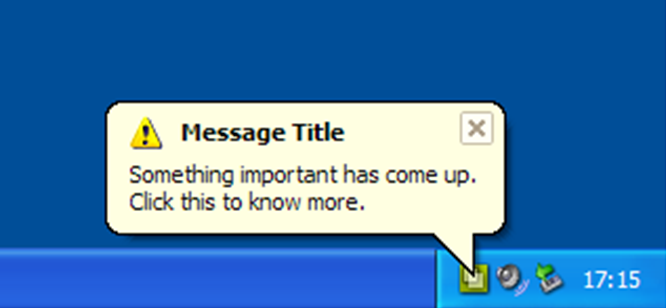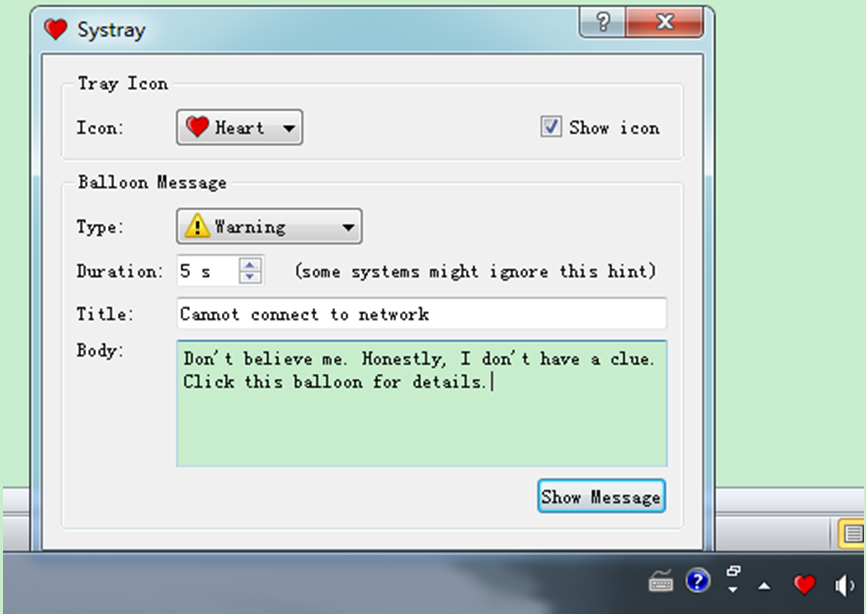QT系统托盘应用程序
在QT中QSystemTrayIcon类提供了创建系统托盘程序的功能。
QSystemTrayIcon类为系统托盘中的应用程序提供图标。
现代操作系统通常会在桌面上提供一个称为系统托盘(system tray)或通知(notification)区域的特殊区域,其中长时间运行的应用程序可以显示图标和短消息。

QSystemTrayIcon类可以在以下平台上使用:
- 所有受支持的Windows版本。
- X11的所有窗口管理器和独立托盘实现,实现了XEmbed系统托盘规范。
- 所有实现D-Bus的X11桌面环境规范,包括最新版本的KDE和Unity。
- 所有受支持的macOS版本。
要检查用户桌面上是否存在系统托盘,请调用QSystemTrayIcon :: isSystemTrayAvailable()静态函数。
要添加系统托盘条目,请创建QSystemTrayIcon对象,调用setContextMenu()以提供图标的上下文菜单,并调用show()以使其在系统托盘中可见。可以使用showMessage()随时显示状态通知消息(“气球消息”)。
如果在构建系统托盘图标时系统托盘不可用,但稍后可用,则QSystemTrayIcon将自动为系统托盘中的应用程序添加条目(如果图标可见)。
当用户激活图标时,会发出activate()信号。
仅在X11上,当请求工具提示时,QSystemTrayIcon接收QEvent ::ToolTip类型的QHelpEvent。此外,QSystemTrayIcon接收QEvent :: Wheel类型的wheel事件。任何其他平台都不支持这些。
QT自带一个例子systray,可学习一下!

该程序是一个基于QDialog的应用程序,只有一个继承于QDialog的Window类。
|
1
2 3 4 5 6 7 8 9 10 11 12 13 14 15 16 17 18 19 20 21 22 23 24 25 26 27 28 29 30 31 32 33 34 35 36 37 38 39 40 41 42 43 44 45 46 47 48 49 50 51 52 53 54 55 56 57 58 59 60 61 62 63 64 65 66 67 68 69 70 71 72 73 74 75 76 77 78 79 80 81 82 83 84 85 86 87 88 89 90 91 92 93 94 95 96 97 98 99 100 101 102 103 104 105 106 107 108 109 110 111 112 113 114 115 116 117 118 119 120 121 122 123 124 125 126 127 128 129 130 131 132 |
int main(int argc, char *argv[])
{ // Initializes the resources specified by the .qrc file with the specified base name. Normally, when resources are built as part of the application, the resources are loaded automatically at startup. // The Q_INIT_RESOURCE() macro is necessary on some platforms for resources stored in a static library.
Q_INIT_RESOURCE(systray); QApplication app(argc, argv); // Returns true if the system tray is available; otherwise returns false. if (!QSystemTrayIcon::isSystemTrayAvailable()) { QMessageBox::critical(, QObject::tr("Systray"), QObject::tr("I couldn't detect any system tray on this system.")); ; } QApplication::setQuitOnLastWindowClosed(false); Window window; Window::Window() QVBoxLayout *mainLayout = new QVBoxLayout; iconComboBox->setCurrentIndex(); setWindowTitle(tr("Systray")); void Window::createTrayIcon() trayIcon = new QSystemTrayIcon(this); // 重写closeEvent实现关闭时隐藏到托盘 // 重写setVisible实现右键菜单的动态变化 // 单击或双击托盘图标动态改变图标,点击滚轮显示气泡信息 void Window::showMessage() |
QT系统托盘应用程序的更多相关文章
- Qt系统托盘
Qt的系统托盘的使用,可比mfc中好多了!他封装了一个专门的QSystemTrayIcon类,建立系统托盘图标.其实在Qt提供的示例程序已经很不错了,$QTDIR\examples\desktop\s ...
- qt系统托盘显示、无主窗体
系统图盘是应用程序经常用到的一个控件,当应用程序需要长时间存在的时候,这个控件会变得非常有用,比如,窗口隐藏,显示,关于.关闭等接口都可以放在图盘中处理,今天与到一个问题,需求是这样的:只需要显示图盘 ...
- 用Qt写软件系列四:定制个性化系统托盘菜单
导读 一款流行的软件,往往会在功能渐趋完善的时候,通过改善交互界面来提高用户体验.毕竟,就算再牛逼的产品,躲藏在糟糕的用户界面之后总会让用户心生不满.界面设计需综合考虑审美学.心理学.设计学等多因素, ...
- 【Qt编程】基于Qt的词典开发系列<十一>系统托盘的显示
本文主要讨论Qt中的系统托盘的设置.系统托盘想必大家都不陌生,最常用的就是QQ.系统托盘以简单.小巧的形式能让人们较快的打开软件.废话不多说,下面开始具体介绍. 首先,新建一个Qt Gui项目,类型选 ...
- 【Qt开发】实现系统托盘,托盘菜单,托盘消息
概述 系统托盘就是在系统桌面底部特定的区域显示运行的程序.windows在任务栏状态区域,linux在布告栏区域.应用程序系统托盘功能,是比较普遍的功能,本篇将详细的介绍如何实现该功能. 演示Demo ...
- QT中自定义系统托盘的实现—c++语言为例
将要介绍的是:QT中自定义系统托盘(systemtray)的一个Demo,希望能帮需要的读者快速上手. 前提假设是诸位已经知道QT中的signals .slot以及资源文件,所以关于这些不会再累述. ...
- 使用QT创建系统托盘
使用QT来创建一个系统托盘,事实上是一件很简单的事.为什么这么说?一是因为QT文档给出了比较详细的例子,二是QT的结构比较优雅,设计风格统一.但是在动手之前,我们要从哪里下手?虽然QT文档给出了一个比 ...
- C#编写WIN32系统托盘程序
基本功能概述: 程序运行后驻留系统托盘,左键呼出,右键退出.后续可加右键菜单. 注册系统案件WIN+F10,呼出程序. 重写系统消息,最小化和关闭按钮隐藏程序 using System; using ...
- WP7系统托盘和应用程序栏
(一)系统托盘和应用程序栏系统托盘(1)显示系统级别的状态信息(2)Apps能隐藏和显示系统托盘Micosoft.Phone.Shell.SystemTray.IsVisible=true;应用程序栏 ...
随机推荐
- Java中Iterator(迭代器)实现原理
在Java中遍历List时会用到Java提供的Iterator,Iterator十分好用,原因是: 迭代器是一种设计模式,它是一个对象,它可以遍历并选择序列中的对象,而开发人员不需要了解该序列的底层结 ...
- MyBatis初探
首先下载MyBatis jar包, 可以去MyBatis中文官网下载 项目中导入MyBatis jar包和JDBC jar包(此处用的MySQL) 新建conf.xml 内容如下: <?xml ...
- GItHub Git 基础教程 常用命令 命令
最近复习了一下Git的使用,简单总结了一些.以供以后查阅和大家参考. 一,安装 首先是Linux下: 打开shell ,输入 sudo apt-get install git-core 之后回车输入密 ...
- std::lock_guard/std::unique_lock
C++多线程编程中通常会对共享的数据进行写保护,以防止多线程在对共享数据成员进行读写时造成资源争抢导致程序出现未定义的行为.通常的做法是在修改共享数据成员的时候进行加锁--mutex.在使用锁的时候通 ...
- Java知识回顾 (8) 集合
早在 Java 2 中之前,Java 就提供了特设类.比如:Dictionary, Vector, Stack, 和 Properties 这些类用来存储和操作对象组. 虽然这些类都非常有用,但是它们 ...
- HRMS(人力资源管理系统)-SaaS架构设计-概要设计实践
一.开篇 前期我们针对架构准备阶段及需求分析这块我们写了2篇内容<HRMS(人力资源管理系统)-从单机应用到SaaS应用-架构分析(功能性.非功能性.关键约束)-上篇><HRMS(人 ...
- tensorflow创建自定义 Estimator
https://www.tensorflow.org/guide/custom_estimators?hl=zh-cn 创建自定义 Estimator 本文档介绍了自定义 Estimator.具体而言 ...
- Spring HttpInvoker 从实战到源码追溯
Spring HttpInvoker 作为 Spring 家族中老牌远程调用模型,深受开发者喜爱. 其主要目的是来执行基于 HTTP 的远程调用(轻松穿越防火墙),并使用标准的 JDK 序列化机制. ...
- redis 4.0.8 源码包安装集群
系统:centos 6.9软件版本:redis-4.0.8,rubygems-2.7.7,gcc version 4.4.7 20120313,openssl-1.1.0h,zlib-1.2.11 y ...
- Linux如何统计进程的CPU利用率[转]
0. 为什么写这篇博客 Linux的top或者ps都可以查看进程的cpu利用率,那为什么还需要了解这个细节呢.编写这篇文章呢有如下三个原因: * 希望在脚本中,能够以过”非阻塞”的方式获取进程cpu利 ...
